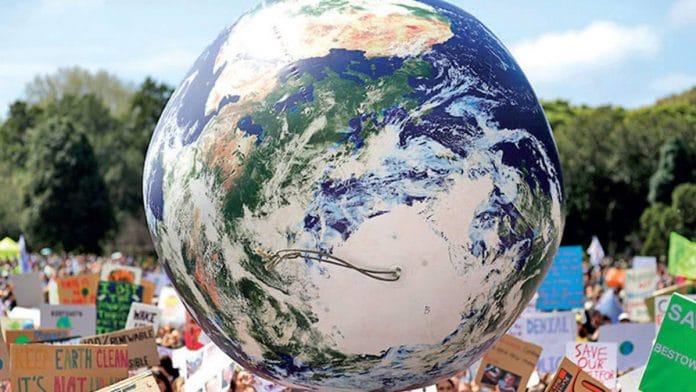New Delhi: The 60th Bonn Climate Conference starting Monday in Germany is set to be a pivotal gathering for global climate action, focusing on the operationalisation of the Loss and Damages Fund and setting the stage for COP29 to be held in Baku, Azerbaijan.
The conference — seen as a mid-point between the annual Conference of the Parties (COPs) of the United Nations Framework Convention on Climate Change (UNFCCC) — will also host the Global Stocktake Annual Dialogue, which will help set updated Nationally Determined Contributions (NDC) for all countries.
Organised by the UNFCCC, the conference, which is scheduled to be held from 3-14 June, will see over 6,000 participants from various countries, organisations, and international committees.
This annual event allows the Subsidiary Bodies (SBs) of the UNFCCC — responsible for Scientific and Technological Advice (SBSTA) and Subsidiary Body for Implementation (SBI) — to deliberate on the intricacies of decisions made at the preceding Conference of Parties (COPs).
The subsidiary bodies are two permanent bodies of the UNFCCC that help the United Nations governing bodies with the technical expertise needed to follow through on treaties, agreements, and conventions agreed by the different countries. All members of the UNFCCC are automatically members of the subsidiary bodies.
As different countries gear up for the Bonn Climate Conference, ThePrint explains what to watch out for in the next two weeks.
Climate finance-loss and damage
Since COP27 officially announced the setting up of the Loss and Damages Fund, there have been several international discussions on streamlining the fund, determining the host country, contributors, and beneficiaries, as well as integrating it with other climate finance mechanisms.
Loss and Damages Fund is a specific financial mechanism agreed upon by all UNFCCC countries to respond to the losses and damages suffered by lower-income countries when dealing with climate change impacts.
The provision of the fund was agreed upon to support countries that are vulnerable to climate change impacts, especially small island developing nations (SIDN) that are inundated by floods, extreme weather events and other climate change-related events.
So far, the fund has been able to raise only about $600 million, which is significantly short of the over $215 billion identified by a United Nations Environment Programme (UNEP) report as necessary for “developing countries to mitigate the impacts of climate change”.
While the World Bank has agreed to host it, the fund’s contributor and beneficiary countries, along with its host nation, remain under negotiation, with decisions anticipated by mid-July.
“This year is critical not only for elevating our climate ambitions but also enhancing the scale and quality of financial support to developing nations,” Harjeet Singh, the Global Engagement Director at the Fossil Fuel Treaty Initiative, told ThePrint.
“The world’s biggest historical polluters, who have consistently fallen short in both domestic climate actions and financial contributions, must now own up to their responsibilities and deliver on their promises,” he added.
At Bonn, three significant events will influence the Loss and Damages Fund — the 10th Technical Expert Dialogue (TED 10), which aims to achieve the global climate finance goal of $100 billion annually by 2025; the final Glasgow Dialogue on Loss and Damage; and discussions on the Warsaw International Mechanism for Loss and Damage.
These dialogues will explore integrating previous committee efforts into the current Fund’s operations and distributing funds equitably among needy countries.
Speaking to ThePrint about India’s role at Bonn and in the climate finance discussions in general, Pooja Ramamurthi, an associate fellow at the Centre for Social and Economic Progress (CSEP), said, “India’s stand is that developed countries need to take more financial responsibility, and it is also one of the few countries that submitted a revised goal for climate finance at $1 trillion per year in March 2024.”
She also pointed out how India’s stance with regard to financing is increasing transparency by multilateral banks. “India supports multilateral development banks (MDB) reform and is calling for more concessional loans and grants as opposed to debt-based money in terms of climate finance,” she highlighted.
Annual global stocktake
Another focal point of the Bonn Climate Conference is the Global Stocktake Annual Dialogue, which will set the foundations for the updated Nationally Determined Contributions (NDCs) that countries have to declare in 2025 under the Paris Agreement.
The NDCs are goals for reducing greenhouse gas emissions, advancing energy transition, and other forms of mitigation and adaptation against climate change that countries have to declare every five years since the 2015 Paris Agreement.
All NDCs are geared towards the common Paris Agreement goal of maintaining global warming at 1.5 degrees Celsius above pre-industrial levels. For example, India’s current NDC includes a plan to reach net-zero emissions by 2070.
As the 2025 NDCs are due, the Global Stocktake Annual Dialogue will aim to support countries with knowledge and plans on how to update their NDCs. This also includes an analysis of the Global Stocktake results from COP28, which is when the UNFCCC reviewed or ‘took stock’ of the progress made by every country on their Paris Agreement goals from 2015.
Simply put, Bonn 2024 will lay all the groundwork for countries to update their NDCs keeping in mind which of their earlier goals have already been achieved.
(Edited by Richa Mishra)
Also Read: India calls for study of melting ice caps, controlled tourism at Antarctic Treaty meet in Kochi






